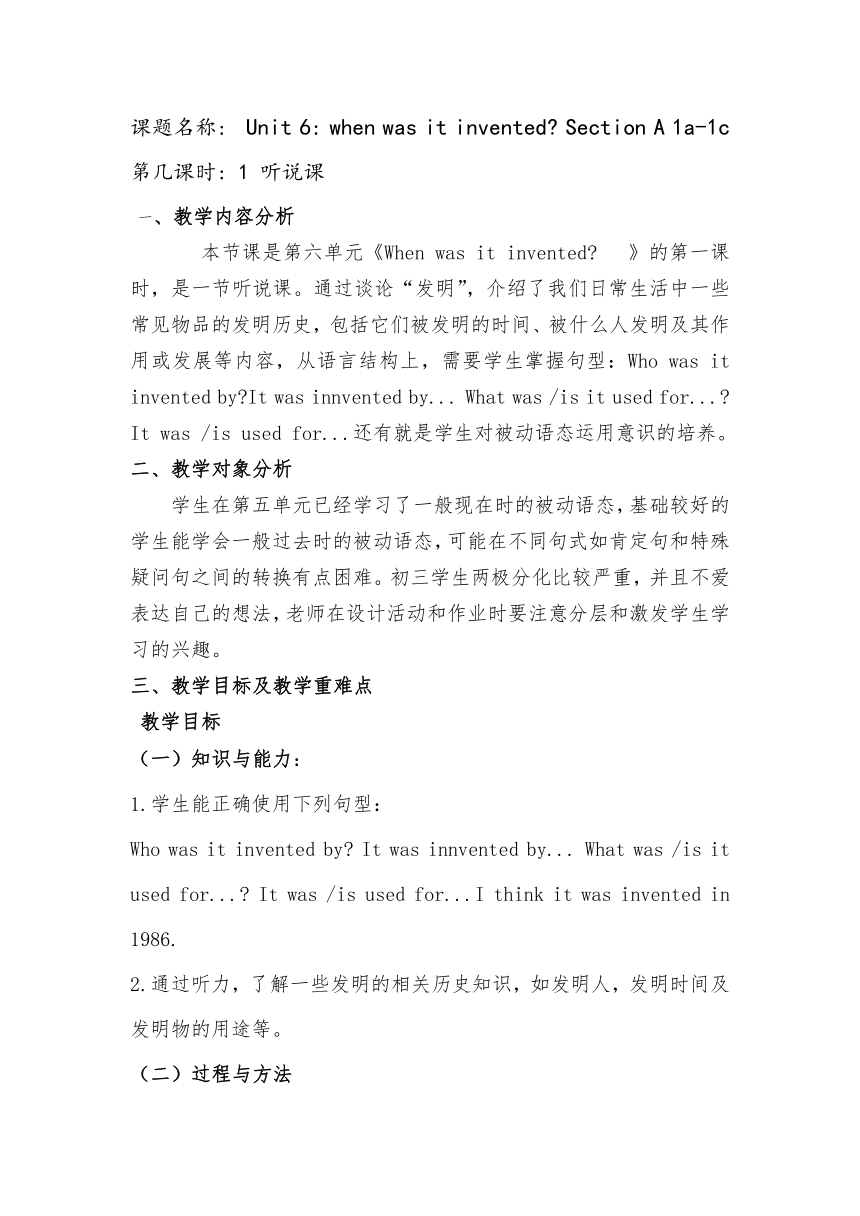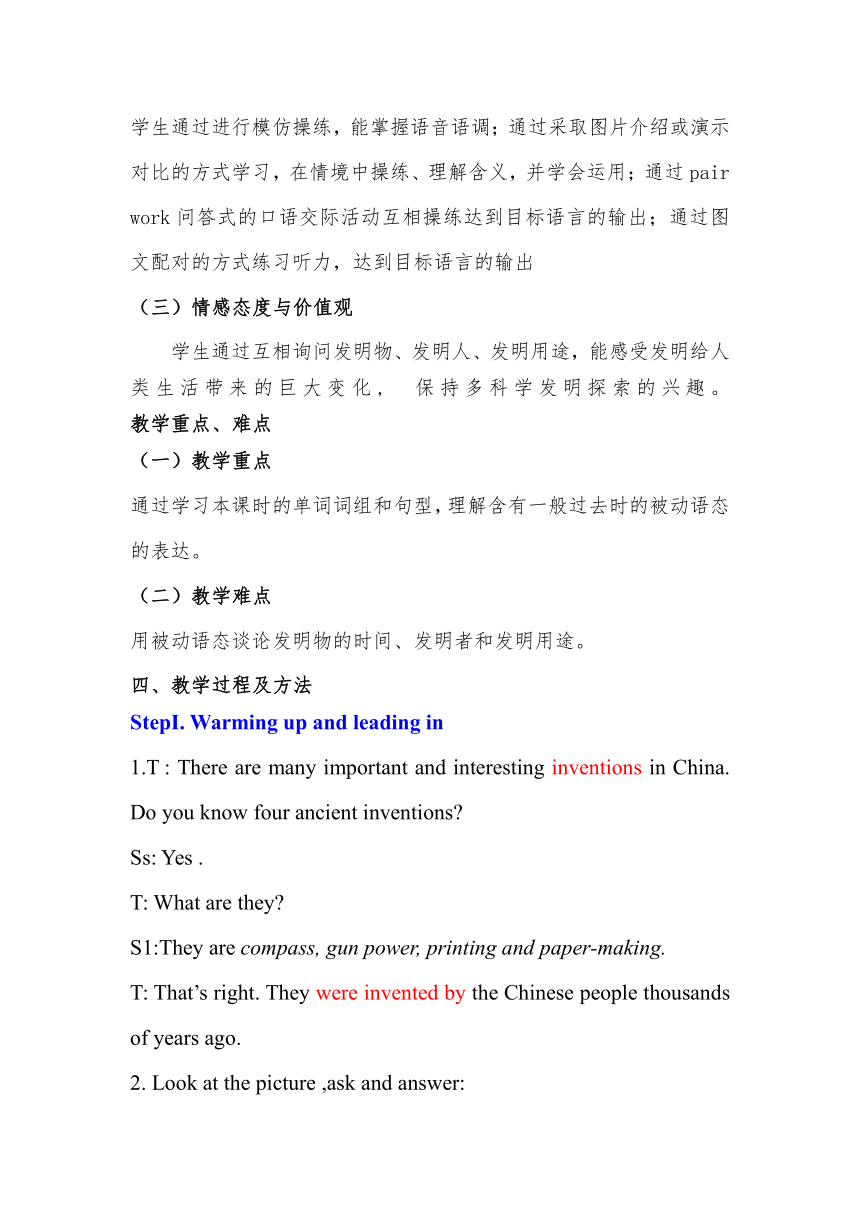人教版九年级全册英语 Unit 6 When was it invented?SectionA 1a-1d 说课教案
文档属性
| 名称 | 人教版九年级全册英语 Unit 6 When was it invented?SectionA 1a-1d 说课教案 |

|
|
| 格式 | doc | ||
| 文件大小 | 35.0KB | ||
| 资源类型 | 教案 | ||
| 版本资源 | 人教新目标(Go for it)版 | ||
| 科目 | 英语 | ||
| 更新时间 | 2022-11-08 09:51:10 | ||
图片预览



文档简介
课题名称: Unit 6: when was it invented Section A 1a-1c
第几课时: 1 听说课
一、教学内容分析
本节课是第六单元《When was it invented 》的第一课时,是一节听说课。通过谈论“发明”,介绍了我们日常生活中一些常见物品的发明历史,包括它们被发明的时间、被什么人发明及其作用或发展等内容,从语言结构上,需要学生掌握句型:Who was it invented by It was innvented by... What was /is it used for... It was /is used for...还有就是学生对被动语态运用意识的培养。
二、教学对象分析
学生在第五单元已经学习了一般现在时的被动语态,基础较好的学生能学会一般过去时的被动语态,可能在不同句式如肯定句和特殊疑问句之间的转换有点困难。初三学生两极分化比较严重,并且不爱表达自己的想法,老师在设计活动和作业时要注意分层和激发学生学习的兴趣。
三、教学目标及教学重难点
教学目标
(一)知识与能力:
1.学生能正确使用下列句型:
Who was it invented by It was innvented by... What was /is it used for... It was /is used for...I think it was invented in 1986.
2.通过听力,了解一些发明的相关历史知识,如发明人,发明时间及发明物的用途等。
(二)过程与方法
学生通过进行模仿操练,能掌握语音语调;通过采取图片介绍或演示对比的方式学习,在情境中操练、理解含义,并学会运用;通过pair work问答式的口语交际活动互相操练达到目标语言的输出;通过图文配对的方式练习听力,达到目标语言的输出
(三)情感态度与价值观
学生通过互相询问发明物、发明人、发明用途,能感受发明给人类生活带来的巨大变化, 保持多科学发明探索的兴趣。 教学重点、难点
(一)教学重点
通过学习本课时的单词词组和句型,理解含有一般过去时的被动语态的表达。
(二)教学难点
用被动语态谈论发明物的时间、发明者和发明用途。
四、教学过程及方法
StepI. Warming up and leading in
1.T:: There are many important and interesting inventions in China. Do you know four ancient inventions
Ss: Yes .
T: What are they
S1:They are compass, gun power, printing and paper-making.
T: That’s right. They were invented by the Chinese people thousands of years ago.
2. Look at the picture ,ask and answer:
T: who invented the paper
S2: Cai Lun invented the paper.
T:when was it invented 教师板书目标语言When was it invented
S3: It was invented in 105A.D.
T: so, we can say
The paper was invented by Cai Lun.
The paper was invented in 105A.D
(引导学生说出一些发明的名称,为降低难度,图片一幅幅展示,为下文要完成的的各种活动做准备顺便引出目标语言When was it invented )
Step2.presentation
1.Look and say:
Show some inventions ,let Ss say who it was invented by and when it was invented.
For example, The printing was invented by Bi Sheng.
The printing was invented around 1041.
(通过操练,让学生进一步巩固目标语言It was invented by...... It was invented in......)
2. Look at the things below. In what order do you think they were invented Discuss them with your group. Then number them [1–4] (1 = fi rst, 4 = last)
A: I think the telephone was invented before the computer.
B: Well, I think the telephone was invented after the computer.
Guessing game:show some inventions, let Ss work in pairs to guess.
A: I think … was invented before …
B: Well, I think … was invented after ….
(大多数孩子对发明有所了解,依据这一特点,老师出示图画先问同学们是否知道这些发明的英文表达,同学们通过观看各种活动竞相说出自己认识的发明,这为学习1a做了很好的铺垫。)
Step3 Listening
While-listening activities
1.Listening for the general idea of the conversations.听取大意
Listen and choose the main idea of the conversations.
The main idea of the conversations is about______
A.Inventions B.Pictures
C.Years. D.Colorful things
2.Listening for the specific ideas听取细节
Listen and match the inventions with the years.
Answers:
a- 1855 b-1971 c-1927 d-1876
3. Language points: 年份的读法
(1)两个数字一组,分为前后两组
(2)千年的读法
(3)前两非四位数的年份的读法!
(4)个数字不为零,后两个数字为零。
Step4 Practice
1. Work in pairs:1c Student B, cover the dates. Student A, ask Student B when the things in the picture 1b were invented. Then change roles and practice again.
2. Brain storm: show some different inventions ,let Ss to guess and choose when it was invented.
3. Work in pairs, ask and answer:
A: When was …invented
B: It was invented in…
A: Who was it invented by
B: It was invented by…
A: What is it used for
B: It is used for doing…
(本部分的内容重在培养学生们口头表达的能力,同时通过游戏、回答问题、练习对话、表演对话等多种训练方式,引导学生更好地内化语言知识。)
Step5 summary
A: When was …invented
B: It was invented in…
A: Who was it invented by
B: It was invented by…
A: What is it used for
B: It is used for doing…
第几课时: 1 听说课
一、教学内容分析
本节课是第六单元《When was it invented 》的第一课时,是一节听说课。通过谈论“发明”,介绍了我们日常生活中一些常见物品的发明历史,包括它们被发明的时间、被什么人发明及其作用或发展等内容,从语言结构上,需要学生掌握句型:Who was it invented by It was innvented by... What was /is it used for... It was /is used for...还有就是学生对被动语态运用意识的培养。
二、教学对象分析
学生在第五单元已经学习了一般现在时的被动语态,基础较好的学生能学会一般过去时的被动语态,可能在不同句式如肯定句和特殊疑问句之间的转换有点困难。初三学生两极分化比较严重,并且不爱表达自己的想法,老师在设计活动和作业时要注意分层和激发学生学习的兴趣。
三、教学目标及教学重难点
教学目标
(一)知识与能力:
1.学生能正确使用下列句型:
Who was it invented by It was innvented by... What was /is it used for... It was /is used for...I think it was invented in 1986.
2.通过听力,了解一些发明的相关历史知识,如发明人,发明时间及发明物的用途等。
(二)过程与方法
学生通过进行模仿操练,能掌握语音语调;通过采取图片介绍或演示对比的方式学习,在情境中操练、理解含义,并学会运用;通过pair work问答式的口语交际活动互相操练达到目标语言的输出;通过图文配对的方式练习听力,达到目标语言的输出
(三)情感态度与价值观
学生通过互相询问发明物、发明人、发明用途,能感受发明给人类生活带来的巨大变化, 保持多科学发明探索的兴趣。 教学重点、难点
(一)教学重点
通过学习本课时的单词词组和句型,理解含有一般过去时的被动语态的表达。
(二)教学难点
用被动语态谈论发明物的时间、发明者和发明用途。
四、教学过程及方法
StepI. Warming up and leading in
1.T:: There are many important and interesting inventions in China. Do you know four ancient inventions
Ss: Yes .
T: What are they
S1:They are compass, gun power, printing and paper-making.
T: That’s right. They were invented by the Chinese people thousands of years ago.
2. Look at the picture ,ask and answer:
T: who invented the paper
S2: Cai Lun invented the paper.
T:when was it invented 教师板书目标语言When was it invented
S3: It was invented in 105A.D.
T: so, we can say
The paper was invented by Cai Lun.
The paper was invented in 105A.D
(引导学生说出一些发明的名称,为降低难度,图片一幅幅展示,为下文要完成的的各种活动做准备顺便引出目标语言When was it invented )
Step2.presentation
1.Look and say:
Show some inventions ,let Ss say who it was invented by and when it was invented.
For example, The printing was invented by Bi Sheng.
The printing was invented around 1041.
(通过操练,让学生进一步巩固目标语言It was invented by...... It was invented in......)
2. Look at the things below. In what order do you think they were invented Discuss them with your group. Then number them [1–4] (1 = fi rst, 4 = last)
A: I think the telephone was invented before the computer.
B: Well, I think the telephone was invented after the computer.
Guessing game:show some inventions, let Ss work in pairs to guess.
A: I think … was invented before …
B: Well, I think … was invented after ….
(大多数孩子对发明有所了解,依据这一特点,老师出示图画先问同学们是否知道这些发明的英文表达,同学们通过观看各种活动竞相说出自己认识的发明,这为学习1a做了很好的铺垫。)
Step3 Listening
While-listening activities
1.Listening for the general idea of the conversations.听取大意
Listen and choose the main idea of the conversations.
The main idea of the conversations is about______
A.Inventions B.Pictures
C.Years. D.Colorful things
2.Listening for the specific ideas听取细节
Listen and match the inventions with the years.
Answers:
a- 1855 b-1971 c-1927 d-1876
3. Language points: 年份的读法
(1)两个数字一组,分为前后两组
(2)千年的读法
(3)前两非四位数的年份的读法!
(4)个数字不为零,后两个数字为零。
Step4 Practice
1. Work in pairs:1c Student B, cover the dates. Student A, ask Student B when the things in the picture 1b were invented. Then change roles and practice again.
2. Brain storm: show some different inventions ,let Ss to guess and choose when it was invented.
3. Work in pairs, ask and answer:
A: When was …invented
B: It was invented in…
A: Who was it invented by
B: It was invented by…
A: What is it used for
B: It is used for doing…
(本部分的内容重在培养学生们口头表达的能力,同时通过游戏、回答问题、练习对话、表演对话等多种训练方式,引导学生更好地内化语言知识。)
Step5 summary
A: When was …invented
B: It was invented in…
A: Who was it invented by
B: It was invented by…
A: What is it used for
B: It is used for doing…
同课章节目录
- Unit 1 How can we become good learners.
- Section A
- Section B
- Unit 2 I think that mooncakes are delicious!
- Section A
- Section B
- Unit 3 Could you please tell me where the restroom
- Section A
- Section B
- Unit 4 I used to be afraid of the dark.
- Section A
- Section B
- Unit 5 What are the shirts made of?
- Section A
- Section B
- Review of Units 1-5
- Unit 6 When was it invented?
- Section A
- Section B
- Unit 7 Teenagers should be allowed to choose their
- Section A
- Section B
- Unit 8 It must belong to Carla.
- Section A
- Section B
- Unit 9 I like music that I can dance to.
- Section A
- Section B
- Unit 10 You're supposed to shake hands.
- Section A
- Section B
- Review of Units 6-10
- Unit 11 Sad movies make me cry.
- Section A
- Section B
- Unit 12 Life is full of the unexpected
- Section A
- Section B
- Unit 13 We're trying to save the earth!
- Section A
- Section B
- Unit 14 I remember meeting all of you in Grade 7.
- Section A
- Section B
- Review of Units 11-14
